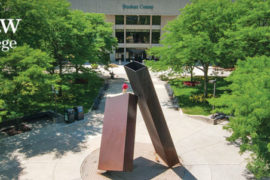It’s not a pretty picture. Michigan ranks dead last among all states in total education revenue growth in the last 25 years.
Last month, Michigan State University released a new study on Michigan School Finance which examines the history of school funding over the last 25 years since Proposal A was passed in 1994.
It shows how Lansing policymakers have prioritized cutting taxes, doling out tax breaks to special interests, and using the School Aid Fund as a slush fund for the state’s General Fund.
Instead of providing adequate education, politicians have used those funds to further their own political interests.
In case you don’t have the time or inclination to read through the full report (90 pages), like me, Dexter is fortunate to have a few people who can distill labyrinthine data down into a summary of understandable bullet points.
Dexter School Board member Dr. Julie Schumaker is one of those people. Here is her breakdown of the study:
Michigan School Finance at the Crossroads
MSU Education Policy Report, David Arsen et al., January 2019
A new study by an MSU shows how drastic funding cuts have been for K-12 education in Michigan.
Proposal A
- Proposal A, passed in 1994, lowered property taxes and narrowed, but did not eliminate, revenue inequalities across districts. It also sharply restricted the ability of local districts to determine the level of funding for their local public schools.
- Per-pupil foundation allowances are 60% higher in wealthy communities than in most districts (In 2016-17, the basic foundation was $7,511, while the effective maximum was $12,063).
- Michigan is one of only 13 states that provide no state aid for facilities. School construction and infrastructure improvements remain a local responsibility, funded entirely by local property taxes.
- Under Proposal A, local districts are precluded from levying taxes to cover additional special education costs, and intermediate districts have very unequal ability to raise revenues for special education services.
- The state’s inequitable and inadequate special education funding impacts both special education and regular education students. Michigan districts on average devote over $500 per student of regular education funds to pay for special education services. In some districts this diversion of funds exceeds. $1,200 per pupil.
Declining Support for K-12 Education
- Michigan ranks dead last among all states in total education revenue growth since Proposal A was passed.
- From 1995 to 2002, the basic foundation increased, on average $185 per year. Over the next 15 years, from 2003 to 2018, it increased on average only $26 per year, substantially below the rate of inflation.
- After adjusting for inflation, total K-12 funding fell by 38% between 2002 and 2015.
- Since 2003, the minimum foundation allowance adjusted for inflation has declined by 26%.

Michigan School Finance Adequacy Studies
- Although, the state now controls most operating revenue available to Michigan’s public schools, it has never calibrated funding levels to the resources needed for students to meet outcome standards.
- The state has established high performance standards for students and schools. It has the responsibility to ensure that they have adequate resources to meet those standards.
- The Michigan School Finance Research Collaborative (MSFRC) study estimates the base per-pupil cost to educate regular education K-12 students at $9,590. Costs for special education, English language learners, and students living in poverty are in addition, and the base per-pupil coast does not include transportation or capital facility costs, and only includes pension costs at 4.6 percent of wages.
- $3.6 billion in additional revenue, above Michigan’s current funding, would be required to implement the recommendations of the adequacy study’s core recommendations.
Michigan’s Tax Policies
- Michigan’s plunge in public school funding is not because the state is poorer than in the past. Michigan’s economy today is larger than it has ever been. Real GDP per capita and personal income per capita are now at their highest levels.
- The reason for declining revenues is that Michigan’s tax effort has declined. State policymakers have chosen to cut tax rates, create tax breaks, and rely on revenue sources that do not grow with the economy.
- In recent years, the School Aid Fund has devoted over $600 million of SAF revenue to activities formerly funded by the General Fund.
- State officials have relied on the School Aid Fund as a slush fund in state budgeting. In the last week of lame duck in December 2018, the legislature shifted $500M in SAF revenues to fund tax refunds, coupled with a reduction in use of SAF for higher education. The legislature also shifted $180 million in K-12 funding to roads & environmental clean-up.
- If Michigan devoted the same fraction of its economy to state and local taxes today as in 1972, it would generate an additional $15 billion in tax revenue per year.
- If Michigan’s tax effort only increased to the 2015 national average, it would generate an additional $3 billion in revenues per year which would nearly restore real school funding to the level that prevailed in 1994.
- Serious consideration should be given to the following tax changes to raise additional revenues – lifting or removing the taxable value cap for property tax, extending the sales tax to services and entertainments, and changing taxes on beer and wine to an ad valorem basis.
- Michigan’s state income tax is currently a 4.25 percent flat tax. The federal government and 36 states have graduated income taxes.
- Policymakers should also seriously reexamine the merits of tax expenditures that have proliferated over time and impact revenues available for public schools – tax exclusions, deductions, deferrals, and credits that benefit specific activities or taxpayers.
- Michigan communities could gain a measure of local control over funding if they were permitted to approve enhancement millages. The state could cap the number of enhancement mills and could offset the potential for enhancement millages to increase inequality by incorporating an equalizing component.
Massachusetts: A Model
- Looking to the highest-performing state, Massachusetts, provides a useful model.
- In 1994, student performance in both Michigan and Massachusetts was above the national average, but far from the top. Per-pupil funding was slightly higher in Michigan.
- Today, Massachusetts students rank atop the National Assessment of the Educational Progress, while Michigan is sinking toward the bottom.
- Massachusetts now spends over $5,500 more per student than Michigan.
- Massachusetts fashioned a bipartisan commitment to raise learning standards, strengthen teacher professional development, and invest heavily in classrooms. State policymakers explicitly coupled increased funding with increased learning expectations and relied on an adequacy study to guide school finance policy.
Summary
- Michigan ranks 50th out of 50 states in the improvement (or lack thereof) of student proficiency between 2003 and 2015.
- Michigan also ranks 50th out of 50 states in the growth of inflation-adjusted K-12 education revenue of over this same period.
- Michigan’s experience demonstrates that accountability and choice policies cannot substitute for adequate funding. By focusing on accountability and choice, Michigan has sought to improve schooling on the cheap.
- The growing consensus of peer-reviewed research indicates that additional funding causes significant increases in student outcomes.

References
Detroit News
Full study report












